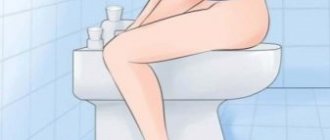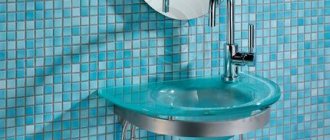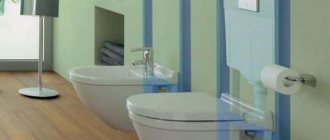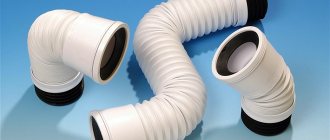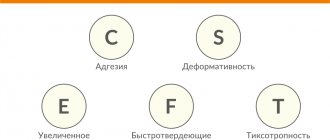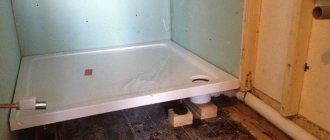The operation of the entire plumbing unit completely depends on the flush mechanism for the toilet. Since it is used to flush waste by pressing a button or lever. He is also responsible for filling the tank with water and closing its supply when the set level is reached. High-quality parts and correct installation will ensure a long service life of the drain mechanism and no problems in the future.
How does he work
This mechanism must perform two functions - controlling the filling of the container with water and flushing. For this purpose, a rather complex mechanical system was developed, which received the general name of shut-off valves. It is designed to almost completely automate the process. The only thing that is required from a person is to press a key (button). The general design of the drain mechanism fittings consists of the work of two elements - a device for regulating the supply of water to the container and a mechanism for its removal.
The plumbing float is responsible for performing the first task. Its design consists of a control membrane, which is connected to the float using a system of levers. When filled with water, the float remains on the surface all the time, gradually rising. Having reached a certain level, which you can set yourself, the lever closes the water supply valve.
The next important element is the water removal system. The simplest model consists of a housing in which a valve is placed that opens (closes) the pipe connecting the tank to the bowl.
Advice
To prevent the creation of an emergency situation (overflow), a hose is provided in the side part. It carries excess water into the bowl.
Thus, it can be summarized that any cistern circuit must perform two functions.
- Fill the container with water in a timely manner, the level of which you can set yourself.
- Ensure that water is drained exactly in the volume for which the mechanism was adjusted.
However, every manufacturer is trying to modernize the device. This is the reason for the emergence of mechanisms that differ in their functionality.
With top and bottom liner
The drainage mechanisms differ from each other in the method of connection - upper and lower side. The top connection is more common and simpler in terms of installation method. The main disadvantage is that the hose from the toilet to the water pipe will be noticeable, since it cannot be hidden. Also, with a side connection, the water will fill with noise if a special soft tube is not installed inside the tank.
With a bottom connection, the hose is invisible, but installation of this type of device is more difficult. Since the water is filled from the bottom up, this toilet cistern does not make noise.
Kinds
The most common is the push-button mechanism. Unlike old lever models, they are more functional and easy to use. The operating principle of push-button devices is quite simple - using a system of levers, water is drained when the button is pressed.
If we talk about a complete classification, we can distinguish the following types.
- Lever. Drainage occurs when the shut-off membrane is raised. The flow of water stops the moment the lever is lowered. Currently, such models are practically not used.
- Button. As the name suggests, water is released by pressing a button. It activates a system of levers that hold the membrane open until a certain water level in the container is reached. It can be single-level (draining the entire volume) or two-level (the design has two buttons, one of which activates a full drain, and the second a partial one.
- Automatically. Installed mainly on expensive models. Drainage is carried out automatically when the corresponding signal is transmitted from the sensors.
The choice of one model or another directly depends on the design of the cistern. Particular attention should be paid to the location of the water supply hose. It can be either side or bottom.
Advice
Manufacturers often provide the opportunity to select a set of shut-off valves with one or another type of water supply connection.
Purpose and design of toilet fittings
The main purpose of any toilet fitting (locking mechanism) is the dosed filling of the flush tank with water and its timely shutoff when filled with the required volume of liquid.
The devices of the locking mechanisms cannot be called the same type, as can be judged by the photos of fittings for toilets on the Internet, but structurally, to perform their function, they all have common elements, which include:
- a float with which the water level is regulated;
- drain mechanism - a cylindrical siphon with a calibrated hole covered with a rubber gasket;
- lever providing water supply;
- ball valve directly connected to the liquid supply.
Design features from different manufacturers
Why know the features of the drainage mechanism in various models? Without this, it is impossible to fix even a small problem that may be specific to a particular device. In this case, you can do the repair yourself without calling a specialist.
Let's look at the most popular models from various brands.
The simple design of the Cersanit toilet cistern directly affects its reliability. It is made according to the classical scheme - the bulb fixes the position of the water supply shut-off mechanism. The most common problems faced by users are.
- Incorrect water supply valve setting. The result is high fluid consumption.
- Large pear size (for Compact model). Sometimes it gets caught on rough thermal walls, which leads to overflow.
But in general, the products of this company can be described as high quality and reliable.
A special feature of the Keramin toilet cistern is the location of the float. They, like their foreign analogues, are mounted not on a horizontal rocker arm, but on the vertical axis of the valve. This design is more reliable and almost completely protected from possible jamming of the float.
In addition, the location of the safety valve should be noted. It is part of the design of the drain system, which makes it possible to significantly reduce the dimensions of the entire mechanism.
One of the simplest and most reliable models to use are models from Porta. The manufacturer initially strived for simplicity in the functionality of the designs. Most models have a one-button water release option. However, thanks to simple adjustment of the location of the bulb, you can set almost any level of filling the container.
At the same time, it is worth noting the design flaws. It is designed for a small tank volume. Therefore, these shut-off valves are installed mainly in their own products.
Sanita and Colombo toilet cisterns are characterized by similar design features. Despite their apparent simplicity, to repair them you need to know the basic principles and rules for carrying out restoration work.
Conclusions and useful video on the topic
The process of adjusting and repairing the shut-off valves of the toilet cistern can be viewed in detail here:
Setting up the tank fittings is not difficult. It is important to study the instructions and understand the general principles of operation of the inlet and locking mechanisms. Attention to detail and accuracy will help to complete all the work correctly.
Have you already encountered setting up drain fittings and were able to cope with this task yourself? Or maybe you know other ways to configure the drain? Please share your experience in the box below.
Troubleshooting the most common problems
During the operation of a plumbing fixture, situations often arise when the drain tank does not operate correctly. In this case, repair work must be carried out. Let's look at the most common situations when a breakdown can be fixed yourself. To do this, you need to know the general structure of the valve.
Constant flow of water
There are two main reasons for this defect. One of them is float misalignment. To resolve, you must perform the following steps.
- Unscrew the locking ring at the shutter release button and remove the cover.
- Then carry out a visual inspection of the float - if it is under water, then it is necessary to lift it. Most often it clings to the drain valve levers.
- After this, you need to check the correct operation of the mechanism. To do this, you need to drain the water and, without putting on the lid, visually check the rise of the float. As soon as it reaches the desired level, the valve should shut off the water supply.
Over time, the O-ring membrane may lose its elasticity. Purchasing it separately is quite problematic. Therefore replacement is recommended. To do this, you need to read the instructions and select the same device model.
Advice
After dismantling the old one, the integrity of the tank gaskets is checked. It is also advisable to replace them.
This especially applies to the elements of fastening it to the bowl. After this, you can install a new drain device.
Now, knowing the structure of the toilet cistern and how to troubleshoot problems, you can carry out minor repairs yourself.
About the author: vremont
« Previous entry
Replacement, setting and adjustment with double button
One of the common causes of problems with the drain mechanism is low-quality parts. They quickly become unusable.
Low-quality plastic products may be initially crooked, and as a result, water will constantly leak. When purchasing an imported drainage mechanism, you should install a coarse filter, since these devices are sensitive to water quality. If it is hard or contains impurities, the drain mechanism will quickly fail.
Before you begin to adjust or replace any parts, you must remove the lid from the toilet tank. To do this, you need to unscrew the water release button (unscrew it using the rim of the button). Having pulled out the button, carefully remove the cover and put it aside so that it does not interfere and is not accidentally damaged.
How to remove a toilet lid
To adjust the filling level of the tank, there is a rod on the float. The less its upper part is visible, the more the tank fills with water. To reduce water consumption, tighten the adjusting screw. As a result, the float is installed lower and the volume of water discharged at one time is reduced.
Send to a friend
Toilet fittings Alcaplast SA2000S bottom connection, stop button
Alcaplast SA2000S tank drain kit
- Flush mechanism A2000
- Water drain start/stop
- Wide range of height adjustment
- Possibility of regulating water drainage
- Intake mechanism A17
- Bottom eyeliner
- For ceramic tank
- Plastic thread 1/2″ (3/8″) in diameter
- Low sensitivity to pressure changes in the water supply system

